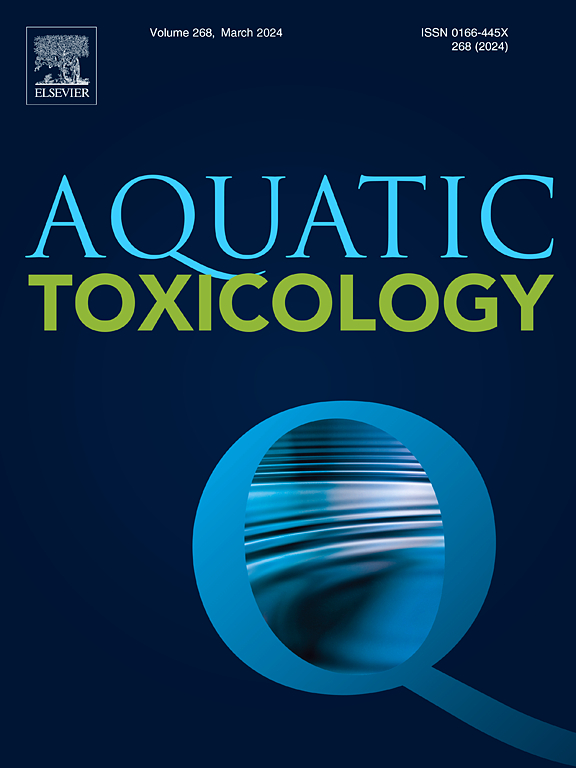多溴联苯醚对淡水生物指示剂斑马贻贝(Dreissena polymorpha Pallas, 1771)有不良影响吗?急性和亚慢性生物标志物评估
IF 4.1
2区 环境科学与生态学
Q1 MARINE & FRESHWATER BIOLOGY
引用次数: 0
摘要
目前的急性和亚慢性实验室研究(96小时和30天)旨在首次提供两种实验浓度可能的不良影响,基于水框架指令2000/60/EC (WFD) -水中最大允许浓度和六种PBDE同系物(PBDE-28(三溴化),PBDE-47(四溴化),PBDE-99, PBDE-100(五溴化),PBDE-153, PBDE-154(六溴化))总和的最大允许浓度。在斑马贻贝中进一步称为∑PBDE (Dreissena polymorpha Pallas, 1771)。因此,我们研究了∑PBDE处理贻贝样品的生物积累过程,计算了生物积累因子,分析了各种细胞生物标志物-代谢酶丙氨酸转氨酶(ALAT)、天冬氨酸转氨酶(ASAT)、胆碱酯酶(ChE)和乳酸脱氢酶(LDH)的活性;消化腺中的抗氧化酶过氧化氢酶(CAT)、谷胱甘肽过氧化物酶(GPx)和谷胱甘肽还原酶(GR)。我们还通过对暴露个体的内收肌血细胞进行中性红保留时间测定来评估溶酶体膜的稳定性。总体而言,结果表明,与对照组相比,所有施加浓度的∑PBDE均改变了急性和亚慢性治疗中的细胞指标(p <;0.05),其中PBDE-28在第96小时的累积量最高,PBDE-100、PBDE-153和PBDE-154在第30天的累积量最高,说明它们对斑马贻贝健康的不良影响可能更大。综上所述,我们的研究有助于更深入地理解调控阈值的生物学相关性和实际意义。它还通过提供实验证据来证明所谓的“安全”浓度在关键水生生物中是否确实是生物良性的,从而与欧洲水立法中嵌入的预防原则保持一致。本文章由计算机程序翻译,如有差异,请以英文原文为准。
Do polybrominated diphenyl ethers cause adverse effects in the freshwater bioindicator zebra mussel (Dreissena polymorpha Pallas, 1771)? An acute and subchronic biomarker assessment
The present acute and subchronic laboratory study (96 hours and 30 days) aimed to provide for the first time the possible adverse effects of two experimental concentrations, based on Water Framework Directive 2000/60/EC (WFD) - maximum allowable concentration in water and maximum allowable concentration in biota of the sum of six PBDE congeners (PBDE-28 (tri-brominated), PBDE-47 (tetra-brominated), PBDE-99, PBDE-100 (penta-brominated), PBDE-153, PBDE-154 (hexa-brominated)), further referred as ∑PBDE, in zebra mussels (Dreissena polymorpha Pallas, 1771). Therefore, we studied the process of bioaccumulation in the treated with ∑PBDE mussel samples and calculated the bioaccumulation factor, analysed the activity of various cellular biomarkers – the metabolic enzymes alanine aminotransferase (ALAT), aspartate aminotransferase (ASAT), cholinesterase (ChE), and lactate dehydrogenase (LDH); the antioxidant enzymes catalase (CAT), glutathione peroxidase (GPx), and glutathione reductase (GR) in the digestive gland. We also evaluated lysosomal membrane stability by applying the neutral red retention time assay to the hemocytes of the adductor muscle in exposed individuals. Overall, the results showed that all applied concentrations of ∑PBDE altered the cellular indicators in both the acute and subchronic treatment compared to the control (p < 0.05), with PBDE-28 showing the highest accumulation levels in mussels on the 96th hour, and PBDE-100, PBDE-153, and PBDE-154 on day 30, thus suggesting they could have more adverse effects on the health of zebra mussel. In light of the above, our study significantly contributes to a deeper understanding of the biological relevance and practical implications of regulatory thresholds. It also aligns with the precautionary principle embedded in the European water legislation by providing experimental evidence on whether supposedly "safe" concentrations are indeed biologically benign in key aquatic organisms.
求助全文
通过发布文献求助,成功后即可免费获取论文全文。
去求助
来源期刊

Aquatic Toxicology
环境科学-毒理学
CiteScore
7.10
自引率
4.40%
发文量
250
审稿时长
56 days
期刊介绍:
Aquatic Toxicology publishes significant contributions that increase the understanding of the impact of harmful substances (including natural and synthetic chemicals) on aquatic organisms and ecosystems.
Aquatic Toxicology considers both laboratory and field studies with a focus on marine/ freshwater environments. We strive to attract high quality original scientific papers, critical reviews and expert opinion papers in the following areas: Effects of harmful substances on molecular, cellular, sub-organismal, organismal, population, community, and ecosystem level; Toxic Mechanisms; Genetic disturbances, transgenerational effects, behavioral and adaptive responses; Impacts of harmful substances on structure, function of and services provided by aquatic ecosystems; Mixture toxicity assessment; Statistical approaches to predict exposure to and hazards of contaminants
The journal also considers manuscripts in other areas, such as the development of innovative concepts, approaches, and methodologies, which promote the wider application of toxicological datasets to the protection of aquatic environments and inform ecological risk assessments and decision making by relevant authorities.
 求助内容:
求助内容: 应助结果提醒方式:
应助结果提醒方式:


